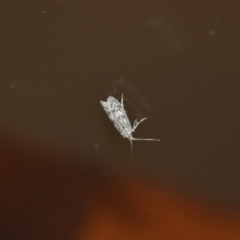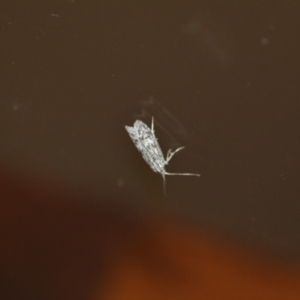A Concealer moth at Wamboin, NSW
Identification history
| Anomozancla scopariella | 14 Feb 2020 | ibaird | ||
| Anomozancla scopariella | 14 Feb 2020 | GlennCocking | ||
| Barea (genus) | 20 Jan 2020 | donhe | ||
| Unidentified | 20 Jan 2020 | natureguy |
Identify this sighting
Please Login or Register to identify this sighting.
6 comments
GlennCocking
wrote:
31 Jan 2020
Hi guys, why are you thinking this is Barea? ( I've been thinking it may be in the Chezala group, but haven't found it yet.)
ibaird
wrote:
31 Jan 2020
Yes, I don't see the palps and head structure or antennae I would expect for Barea sp. genus.
MichaelMulvaney
wrote:
31 Jan 2020
Sorry I was just trying to move an oldish record on - will leave the moths alone
thanks michael
thanks michael
donhe
wrote:
1 Feb 2020
I think I see the dark points of two upcurved palps silhouetted on the head, foreshortened because we are looking down on them.
Oecophoridae because of the size.
Barea because that genus seems to have many of its species having off-white forewings with vague patterns composed of dark speckles, and have the truncated elliptical outline of this dorsal view.
Oecophoridae because of the size.
Barea because that genus seems to have many of its species having off-white forewings with vague patterns composed of dark speckles, and have the truncated elliptical outline of this dorsal view.
GlennCocking
wrote:
15 Feb 2020
I too think gelechioid palpi are visible. I haven't found any wing pattern like this in the Barea genus. There are a number of moths with longitudinal dark and lighter streaks in the Oecophoridae and Xyloryctidae (and also Pedois (Depressariidae) and Ardozyga (Gelechiidae) but they are less likely). I think Anomozancla scopariella is the best match. The other options in the Chezala group are generally more finely and uniformly streaked, and the xylo options and Pytinaea are courser. I suggest we park the record as Anomozancla scopariella (which has been recorded previously on Black Mountain) until we have more photos
ibaird
wrote:
15 Feb 2020
Comparing this with D. Hobern's single photo of this species from Aranda on the ALA, overall it looks similar but only the tip of the palpi seem to be visible in this specimen, but they are the same colour as the Aranda specimen i.e black. We cannot see the full palpi structure which is more evident in the Aranda example. he pattern of hinwing markings are similar, but don't math as much I would like.
Please Login or Register to comment.
Nearby sightings
Location information
- Coordinates 149.274041-35.254411
- Maps QPRC LGA
- Places Wamboin, NSW
Sighting information
- 1 - 3 Abundance
- 27 Dec 2019 02:40 AM Recorded on
- natureguy Recorded by
Additional information
- 12mm to 25mm Animal size
- Unknown Gender
Species information
- Anomozancla scopariella Scientific name
- A Concealer moth Common name
- Not Sensitive
- Local native
- Non-Invasive
- 603.1m Recorded at altitude
- Machine learning
- External link More information
Record quality
- Images or audio
- More than one media file
- Confirmed by an expert moderator
- Nearby sighting(s) of same species
- GPS evidence of location
- Description
- Additional attributes







































































